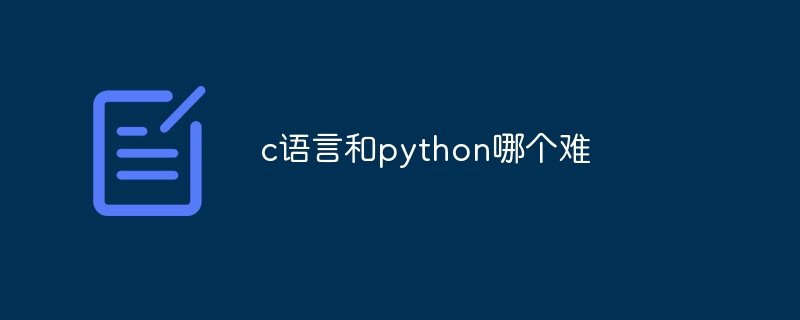
The difficulty of learning C language and Python depends on personal background and goals. For beginners, Python is easier to get started with due to its concise syntax and rich libraries. For experienced programmers, the difference in difficulty between the two may not be big, and in some cases, C language is even more intuitive and flexible.

When comparing the difficulty of C language and Python, we first need to make it clear: difficulty is a relative concept, which depends on the learner’s background, experience and learning target. For beginners, Python is generally considered easier to learn than the C language because of its concise and readable syntax, and its powerful library and framework support. However, for experienced programmers, the difference in difficulty between the two may not be so obvious, and in some cases, C may even be more intuitive and flexible.
The following is a detailed analysis of the difficulty of C language and Python:
1. Syntax and semantics
1. C language: syntax of C language It is relatively cumbersome and requires more attention to details. For example, variables need to be declared before they are used, and the type of the variable must be explicitly specified. In addition, pointers and memory management in C language are also concepts that are difficult for beginners to master. Pointer operations may lead to memory leaks, wild pointers and other problems, requiring programmers to be highly vigilant.
2. Python: Python’s syntax is concise, clear and easy to understand. It supports dynamic typing, eliminating the need to declare variable types in advance. At the same time, Python provides a wealth of built-in functions and libraries, making writing code easier. In addition, Python also supports advanced features such as list comprehensions and generator expressions, making the code more concise and efficient.
2. Learning curve
1. C language: For people who have no programming experience, learning C language may encounter certain difficulties. Since C language involves low-level concepts and memory management, beginners need to spend more time to understand these concepts. In addition, error troubleshooting in C is relatively difficult because the compiler usually provides only limited error information.
2. Python: Python has a relatively gentle learning curve and is suitable for beginners to get started. Due to its concise syntax and powerful library support, beginners can master the basic usage of Python faster. In addition, the Python community is active and rich in resources, which helps beginners solve problems quickly.
3. Application fields
1. C language: C language is mainly used in system-level programming, embedded system development, game development and other fields. In these areas, C's performance advantages and low-level access capabilities make it the language of choice. However, this also means that using C requires more low-level knowledge and experience.
2. Python: Python is widely used in data analysis, artificial intelligence, web development and other fields. Its concise syntax and rich library support make Python highly productive in these fields. In addition, Python is also a popular language in the fields of scientific computing and machine learning, with numerous frameworks and tools.
4. Performance
1. C language: C language is a compiled language with high execution efficiency. It can directly access hardware and memory, making C language more advantageous in scenarios with high performance requirements.
2. Python: Python is an interpreted language with relatively low execution efficiency. However, with the development of Python's JIT (just-in-time compilation) technology, its performance has been greatly improved. In addition, Python's ease of use and strong library support make it still competitive in many scenarios.
5. Extensibility and portability
1. C language: C language has good scalability and portability. Because the C language is closely related to the underlying hardware and operating system, it can be compiled and run on a variety of platforms. In addition, C language also supports mixed programming with other languages, which has high flexibility.
2. Python: Python also has good scalability and portability. Python code can run on a variety of operating systems and supports cross-platform development. In addition, Python also provides a wealth of interfaces and tools, making interaction with other languages easy.
To sum up, there are certain differences in difficulty between C language and Python. For beginners, Python's concise syntax and powerful library support make it easier to get started; while for scenarios that need to deal with low-level details and performance requirements, C language has more advantages. However, this does not mean that C language is necessarily more difficult to learn than Python, because the difficulty also depends on the learner's background, experience, and learning goals. In practical applications, the appropriate language can be selected according to specific needs.
The above is the detailed content of Which is more difficult, c language or python?. For more information, please follow other related articles on the PHP Chinese website!




